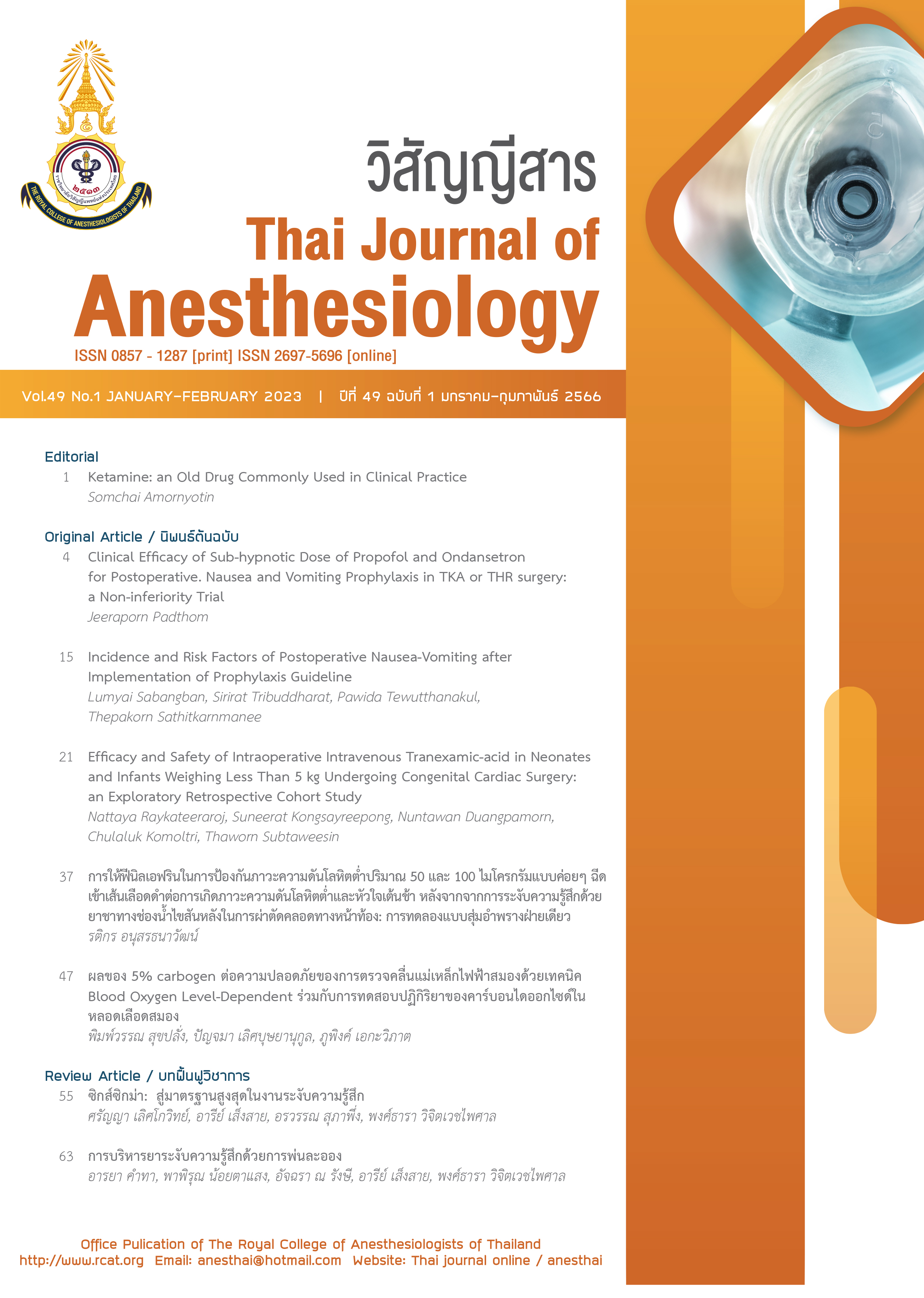Incidence and Risk Factors of Postoperative Nausea- Vomiting after Implementation of Prophylaxis Guideline
Main Article Content
Abstract
Introduction: Postoperative nausea-vomiting (PONV) is one of the major complications in patients undergoing general anesthesia with incidence between 20% and 30%. PONV can cause serious problems. Our department has developed and implemented a PONV prophylaxis guideline for high risk PONV patients since 2013, however, PONV still presents. Objective: To identify the incidence and risk factors of PONV after implementation of PONV prophylaxis guideline. Methods: A retrospective study was performed in 443 adult patients undergoing elective surgery under general anesthesia in Srinagarind Hospital from January 2014 to December 2014 to identify the incidence and risk factors of PONV. From literature review, we identified 20 risk factors for PONV. All relevant risk factors were assessed for crude odds and adjusted odds ratios using binary logistic regression analysis to identify the relevant risk factors. Results: The incidence of PONV was 10.8%. Female gender had a risk ratio of 2.663 (95% CI: 1.350-5.255). Patients who had postoperative numeric pain score (NRS) ≥ 5 had risk ratio of 2.040 (95% CI: 1.084-4.228). Interestingly, combined general anesthetic technique with spinal or epidural block could reduce PONV with risk ratio of 0.278 (95% CI: 0.100-0.777). Conclusion: After implementation of PONV prophylaxis guideline, the incidence of PONV is 10.8%. The risk factors for PONV are female gender and postoperative NRS ≥ 5, while combined general anesthesia with spinal or epidural block reveals protective effect.
Article Details

This work is licensed under a Creative Commons Attribution-NonCommercial-NoDerivatives 4.0 International License.
References
Chatterjee S, Rudra A, Sengupta S. Current concepts in the management of postoperative nausea and vomiting. Anesthesiol Res Pract. 2011;2011:748031.
Doubravska L, Dostalova K, Fritscherova S, Zapletalova J, Adamus M. Incidence of postoperative nausea and vomiting in patients at a university hospital. Where are we today? Biomed Pap Med Fac Univ Palacky Olomouc Czech Repub. 2010;154:69-76.
Kappen TH. Risk-tailored prophylaxis for postoperative nausea and vomiting: has the big little problem gotten any smaller? Br J Anaesth. 2018;120:9-13.
Khanethawai S, Tribuddharat S, Sathitkarnmanee T, Sinkueakunkit A, Prakrankamanant D. Anesthesia related postoperative nausea/vomiting in adult cardiovascular and thoracic surgical patients in Queen Sirikit Heart Center of the Northeast: incidence and related factors. Srinagarind Med J. 2017;32:338-43.
Ngamsaengsirisup K, Tribuddharat S, Sathitkarnmanee T, Thananun M. Postoperative nausea-vomiting in adult patients undergoing thoracic and cardiovascular surgery in Srinagarind Hospital: incidence and risk factors. Thai J Anesthesiol. 2018;44:58-62.
Apfel CC, Laara E, Koivuranta M, Greim CA, Roewer N. A simplified risk score for predicting postoperative nausea and vomiting: conclusions from cross-validations between two centers. Anesthesiology. 1999;91:693-700.
Choi JB, Shim YH, Lee YW, Lee JS, Choi JR, Chang CH. Incidence and risk factors of postoperative nausea and vomiting in patients with fentanyl-
based intravenous patient-controlled analgesia and single antiemetic prophylaxis. Yonsei Med J. 2014;55:1430-5.
Myklejord DJ, Yao L, Liang H, Glurich I. Consensus guideline adoption for managing postoperative nausea and vomiting. WMJ. 2012;111:207-13.
Habib AS, Gan TJ. Evidence-based management of postoperative nausea and vomiting: a review. Can J Anaesth. 2004;51:326-41.
Gan TJ, Meyer TA, Apfel CC, et al. Society for Ambulatory Anesthesia guidelines for the management of postoperative nausea and vomiting. Anesth Analg. 2007;105:1615-28.
Le TP, Gan TJ. Update on the management of postoperative nausea and vomiting and postdischarge nausea and vomiting in ambulatory surgery. Anesthesiol Clin. 2010;28:225-49.
Sawatzky JA, Rivet M, Ariano RE, Hiebert B, Arora RC. Post-operative nausea and vomiting in the cardiac surgery population: who is at risk? Heart Lung. 2014;43:550-4.
Skolnik A, Gan TJ. Update on the management of postoperative nausea and vomiting. Curr Opin Anaesthesiol. 2014;27:605-9.
Tabachnick BG, Fidell LS. Using multivariate statistics. Boston: Pearson/Allyn & Bacon; 2007.
Dewinter G, Staelens W, Veef E, Teunkens A, Van de Velde M, Rex S. Simplified algorithm for the prevention of postoperative nausea and vomiting: a before-and-after study. Br J Anaesth. 2018;120:156-63.
Jorgensen H, Wetterslev J, Moiniche S, Dahl JB. Epidural local anaesthetics versus opioid-based analgesic regimens on postoperative gastrointestinal paralysis, PONV and pain after abdominal surgery. Cochrane Database Sys Rev. 2000:CD001893.
Guay J, Nishimori M, Kopp SL. Epidural local anesthetics versus opioid-based analgesic regimens for postoperative gastrointestinal paralysis, vomiting, and pain after abdominal surgery: a cochrane review. Anesth Analg. 2016;123:1591-602.
Cao X, White PF, Ma H. An update on the management of postoperative nausea and vomiting. J Anesth. 2017;31:617-26.


